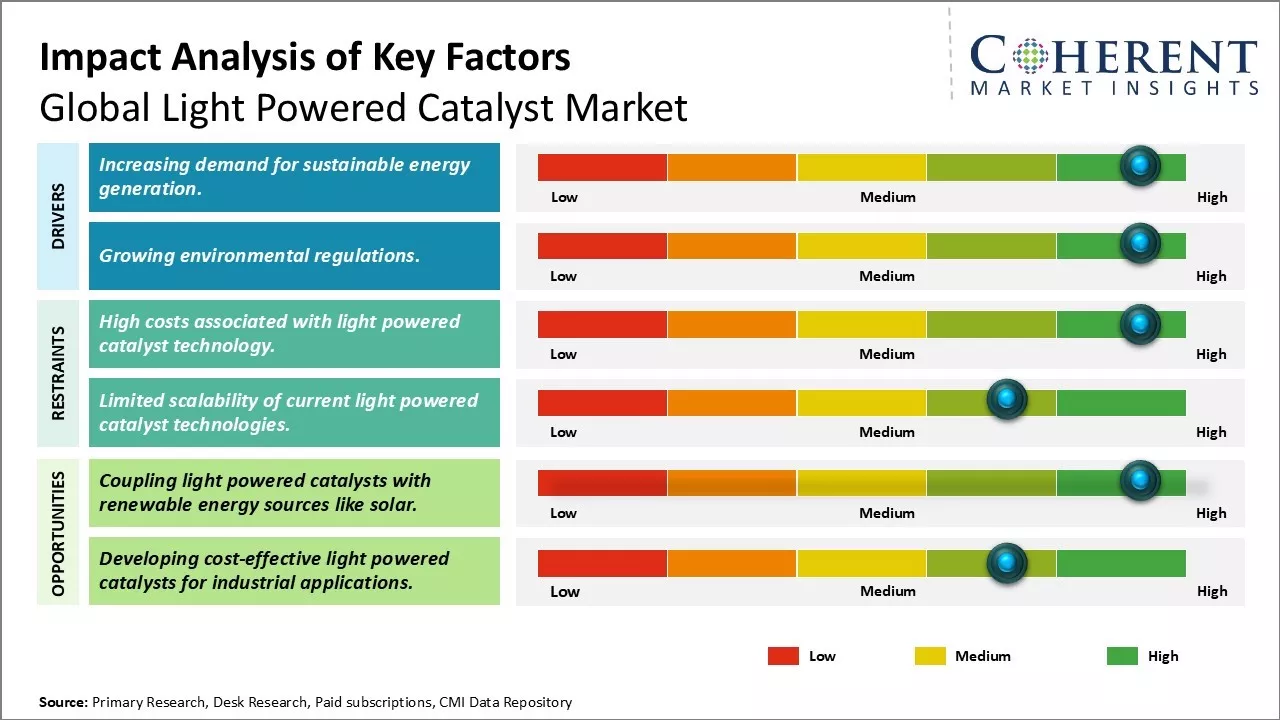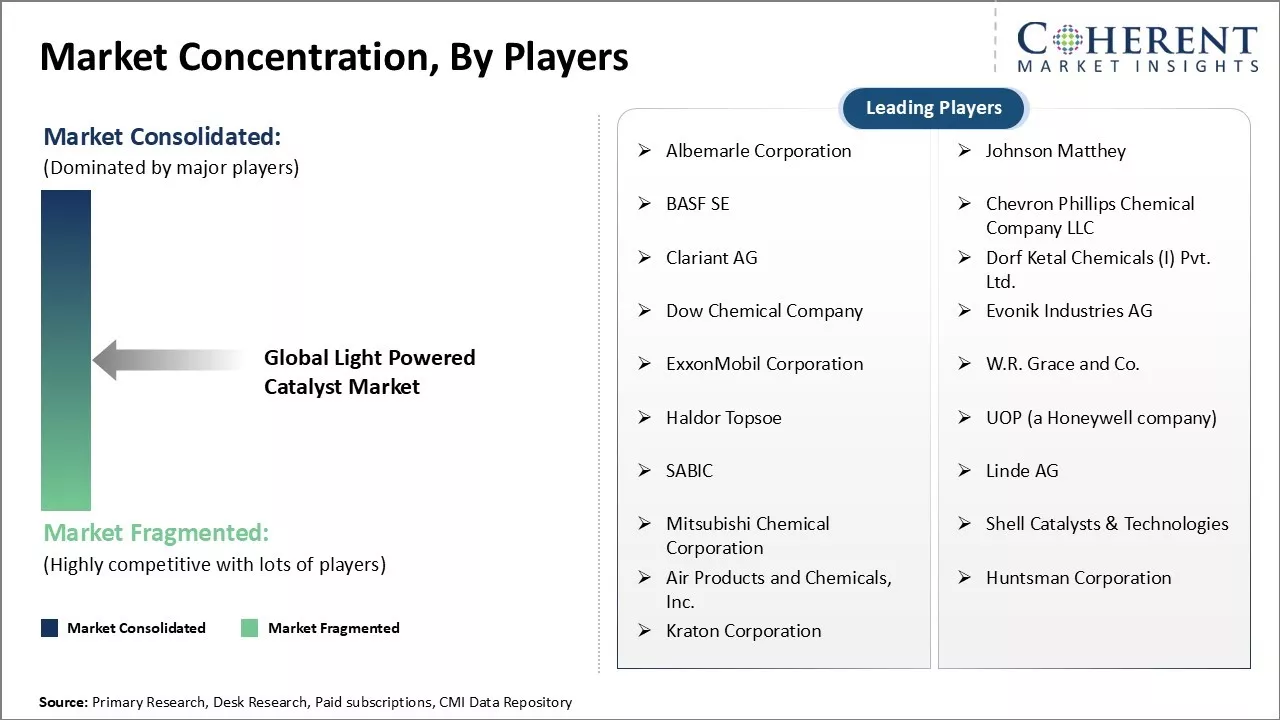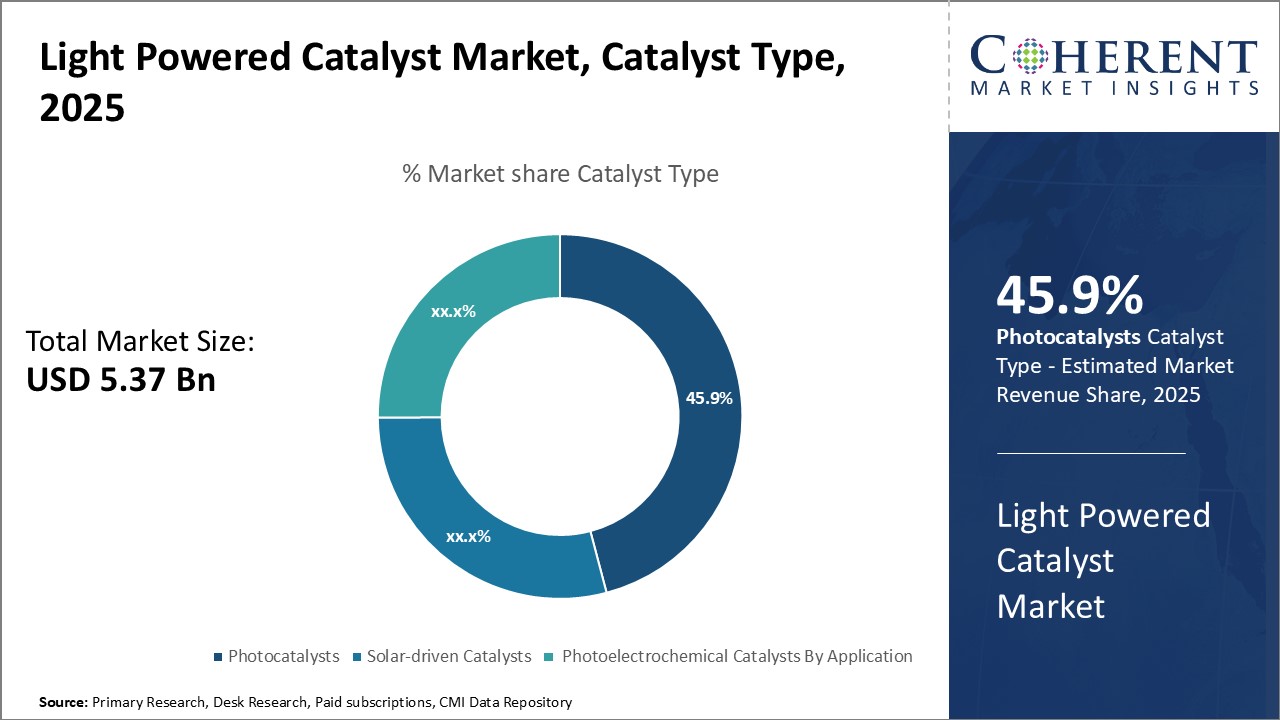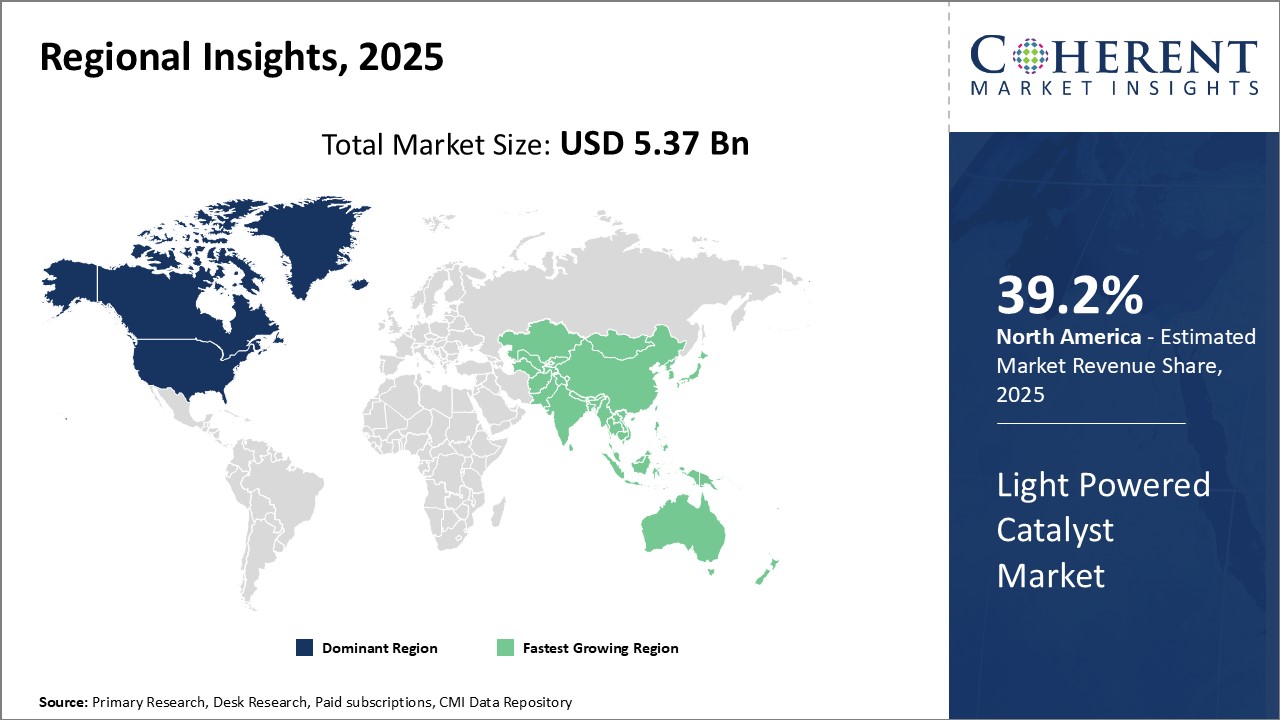Light Powered Catalyst Market Size and Trends
The global light powered catalyst market is estimated to be valued at USD 5.37 Bn in 2025 and is expected to reach USD 12.19 Bn by 2032, exhibiting a compound annual growth rate (CAGR) of 12.4% from 2025 to 2032.

Discover market dynamics shaping the industry: Download Free Sample
The growth can be attributed to increasing applications of photocatalyst technologies in various industries. Photocatalyst are gaining traction owing to their effectiveness in utilizing solar energy for the production of clean fuels and degradation of organic pollutants. Moreover, ongoing research and development activities to improve the efficiency and stability of light powered catalysts would provide further opportunities for market growth. However, high material cost and requirement of precise operating conditions may hamper the market expansion to some extent. But increasing awareness about environmental protection and investments in renewables are likely to create growth opportunities for the light powered catalyst market in the coming years.
Market Driver - Increasing demand for sustainable energy generation
With growing concerns over climate change and greenhouse gas emissions, governments and organizations across the world are putting significant focus on developing sustainable sources of energy. Transitioning to renewable energy options can help reduce dependence on fossil fuels which are a major cause of air and water pollution. Technologies that utilize natural energy from the sun, wind, and water are gaining prominence. However, traditional solar and wind power plants require large installations to generate meaningful amounts of energy. This is driving interest in lighter and smaller scale energy solutions.
Light powered catalysts have potential in this regard. They enable the harvesting of solar energy through chemical reactions triggered by light. Miniaturized versions of these catalysts can be deployed on wider surfaces like building walls and windows to generate distributed electric power. This decentralized approach has attracted engineers and businesses scouting for innovative cleantech. As awareness rises on the environmental hazards of coal and petroleum, more companies and consumers are prioritizing sustainability in their energy sourcing. If proven efficient at scale, light powered catalysts could emerge as a viable supplemental power source for residences, neighborhoods, and smaller industries.
Governments too see potential long-term economic and social benefits. Substituting some fossil fuels with indigenous renewable sources enhances energy security by reducing external dependence and vulnerabilities linked to global commodity price fluctuations or geopolitical risks. It also opens opportunities for local green job creation. Some administration are actively evaluating light powered catalyst technologies through funding public research or setting policy incentives. A coordinated global push for eco-friendly alternatives can significantly curb pollution levels in the coming decades. Such macro trends make the market for cleaner decentralized energy solutions increasingly attractive for sustained investments.
Market Concentration and Competitive Landscape

Get actionable strategies to beat competition: Download Free Sample
Growing Environmental Regulations
With growing acknowledgment of dangers from unchecked emissions, environment protection is rising up the policy agenda worldwide. Stricter pollution control norms are being instituted to limit the discharge of harmful carbon compounds and toxic substances into air and water bodies. Non-compliance entails heavy penalties as authorities get more serious about sustainability targets. Industries are under pressure to adopt greener processes/fuels and minimize waste. Meanwhile public are also more environmentally conscious in selecting brands and putting pressure on big corporations to demonstrate responsible credentials.
Regulators are also stepping efforts to assess and control pollution from the transport sector which is a major contributor. Tightening fuel efficiency standards for vehicles are pushing automotive manufacturers to fast-track electric options. Logistics companies too feel impetus to transition their fleets to reduce the carbon footprint. Growing regulatory scrutiny on energy generation sources is making coal and fossil fuel-based plants sub-optimal long-term choices. Utilities need sustainable alternatives to power future economic growth within compliance.
Light powered catalysts represent an opportunity to meet these regulatory pulls. Having potential for off-grid applications, they can help industries, businesses, and communities supplement their electricity requirements without adding to central pollution. Solar paint or windows that generate clean electricity also reduce dependence on large centralized plants under growing performance pressure. Proactive organizations are evaluating investment into such distributed renewable technologies to transition proactively before regulations mandate change. Compliance departments also see these novel solar solutions helping comply with sustainability goals in a cost-effective distributed way. Rising environmental awareness and ambitions are strengthening the role of the light powered catalysts market.
Key Takeaways from Analyst:
Driven by the increasing demand for renewable energy sources and the need to develop more sustainable chemical production methods, light powered catalysts are emerging as a promising technology. Their ability to drive chemical reactions utilizing only sunlight as an energy source allows for more eco-friendly approaches.
North America currently dominates the market due to high R&D investments and the presence of key players in the region. However, Asia Pacific is expected to offer the most lucrative opportunities with countries like China and India ramping up investments in solar energy. Rapid industrialization and growing environmental regulations will drive the need for green chemicals and fuel production.
While the cost of materials involved in light activated catalysis remains a challenge, ongoing research in materials science and nanotechnology is likely to address this bottleneck. Development of stable, cost-effective, and reusable photocatalyst systems can help unlock the vast potential of this industry. Successful commercialization of water splitting and carbon dioxide reduction processes would be a major breakthrough.
Market Challenge - High costs associated with light powered catalyst technology
One of the key challenges currently facing the global light powered catalyst market is the high costs associated with the technology. Developing efficient light powered catalysts that can drive chemical reactions using solar energy or artificial light continues to require substantial investments in research and development. Producing these catalysts at industrial scales also remains an expensive process that relies on specialty materials and complex manufacturing methods. This has kept the prices of light-powered catalysts significantly higher compared to traditional thermal catalysts. The high capital costs have limited their adoption for large-scale commercial applications. Additionally, sustaining continuous illumination also demands high operating expenses for energy-intensive light sources. Addressing issues related to manufacturing efficiencies and bringing down the production costs will be critical for unlocking the full market potential of this technology. Overcoming the financial barrier is important to make light powered catalysts economically viable across different end-use industries.
Market Opportunity: Coupling light powered catalysts with renewable energy sources like solar
One major opportunity for the global light powered catalyst market is coupling this technology with renewable energy sources like solar power. As light powered catalysts require a source of illumination to drive chemical reactions, integrating them with solar energy harvesting could provide a sustainable solution. The increased focus on solar power generation across the globe in line with climate change goals offers a promising application avenue. By utilizing daylight or produced from solar panels, these catalysts can perform various reactions without consumption of fossil fuels. This has potential to facilitate the development of greener technologies like artificial photosynthesis for producing fuels and chemicals. It can also help reduce energy costs over long-term by substituting electricity bills with free sunlight. Successful demonstrations of such integrated solar-light catalyst systems can boost their commercial adoption and spur investments in further research and development.

Discover high revenue pocket segments and roadmap to it: Download Free Sample
Insights by catalyst type: Photocatalysts Dominate Due to their Versatility and Effectiveness
In terms of catalyst type, photocatalysts is expected to contribute 45.9% share of the global light powered catalyst market in 2025, owing to their versatility and effectiveness across various environmental and energy applications. Photocatalysts harness the power of light, typically sunlight or artificial UV light, to drive catalytic reactions like degradation of organic pollutants. This photoactivated property allows them to function continuously as long as there is a light source, making them well-suited for applications that require persistent catalytic activity.
Photocatalysts are most widely used for environmental remediation due to their ability to break down hazardous chemicals and toxins in both air and water through oxidation and reduction reactions under illumination. They can remove volatile organic compounds from indoor and ambient air as well as deactivate pathogens, making them valuable for air and water purification. Their self-cleaning and antimicrobial functions have led to increasing use of photocatalytic coatings on construction materials as well.
In the energy sector, photocatalysts facilitate the conversion of sunlight to chemical fuels through artificial photosynthesis and photoelectrochemical cells. They promote the generation of hydrogen gas from water splitting and help produce useful derivatives from carbon dioxide. As renewable energy production and carbon capture technologies advance, the demand for photocatalytic materials in this domain will continue growing substantially.
The versatility of photocatalysts in degradation, energy conversion, and materials applications stem from the diversity of photocatalytic materials available. Titanium dioxide remains the most widely used photocatalyst due to its high quantum efficiency, chemical stability and low cost. However, other metal oxide semiconductors and composite photocatalysts are also gaining prominence due to improved light absorption and charge separation properties. Continuous research on novel photoactive catalyst design and synthesis will further expand application opportunities for this dominant catalyst type.
Insights by application: Environmental Remediation Dominates Due to Stringent Regulations and Health Hazards
Based on application, environmental remediation is expected to contribute 35.1% share of the global light powered catalyst market in 2025. This segment captures the largest revenue owing to stringent environmental standards as well as health and safety regulations regarding pollution control. Hazardous waste and contaminated sites require thorough cleansing, while industrial emissions and urban air quality are areas of increasing governmental focus worldwide.
The use of light powered catalysts is particularly important for environmental remediation due to the persistence of many toxic pollutants. Photocatalytic and photoelectrochemical processes allow for the continuous breakdown of stubborn organic contaminants in all phases as well as inactivation of drug-resistant microbes. This makes catalyst-driven remediation methods highly effective for cleaning complex pollution scenarios that are challenging to address through conventional means.
Water treatment holds a substantial portion of the environmental remediation segment. Access to clean water is a growing global concern, while industrial effluents contain numerous hard-to-remove compounds. Light activation enables advanced oxidation processes for thorough purification and disinfection of wastewater. Similarly, polluted soil and groundwater remediation projects form a major application area owing to widespread contamination incidents from industrial activities.
With increasing environmental awareness and more stringent regulations worldwide governing air and water quality, the demand for non-hazardous, sustainable remediation technologies like light powered catalysts will continue growing strongly. This provides an attractive market opportunity for various players focused on environmental solutions.
Regional Insights

Need a Different Region or Segment? Download Free Sample
North America has established itself as the dominant region in the global light powered catalyst market. The region is expected to hold 39.2% of the market share in 2025. With countries, such as the U.S. and Canada, having strong industrial bases and presence of major catalyst manufacturers, the market has continually grown over the past decades. The region is an early adopter of new technologies and has seen increased investments in research and development of advanced catalyst materials. This has enabled North American companies to introduce innovative product offerings and solutions catered for the local needs. In addition, the highly globalized nature of trade in the region ensures import and export of catalyst products to different markets.
Another major factor for North America's prominence is the mature chemical processing industry that employs various catalytic processes at large scales of production. Sectors like petroleum refining, petrochemicals, and bulk chemicals have fueled the regional catalyst consumption. With rising energy demand and chemicals production in the U.S. especially, there is steady long-term demand for advanced catalysts to boost efficiency and maximize yields. This augurs well for the future growth prospects of light powered catalyst providers.
The Asia Pacific region has emerged as the fastest growing market for light powered catalyst globally. Booming economies like China and India are undergoing rapid industrialization which has boosted the regional demand. Both nations are investing heavily in expanding their manufacturing base and upgrading existing production facilities that employ catalyst-assisted reactions. This presents lucrative opportunities for catalyst manufacturers. Additionally, the bulk and intermediate chemicals industry in Asia Pacific is progressively moving toward advanced production technologies, thereby supporting the light powered catalyst uptake.
The extensive trade relationships Asia Pacific shares with other major economies also make it an important gateway. With China continuing as the world's manufacturing hub, there is constant movement of catalyst shipments through the region's ports to service the global demand. Overall, the Asia Pacific light powered catalyst market is forecast to witness strong growth fueled by the growing consumption requirements across various end-use sectors.
Market Report Scope
Light Powered Catalyst Market Report Coverage
| Report Coverage | Details | ||
|---|---|---|---|
| Base Year: | 2024 | Market Size in 2025: | USD 5.37 Bn |
| Historical Data for: | 2020 To 2024 | Forecast Period: | 2025 To 2032 |
| Forecast Period 2025 to 2032 CAGR: | 12.4% | 2032 Value Projection: | USD 12.19 Bn |
| Geographies covered: |
|
||
| Segments covered: |
|
||
| Companies covered: |
Albemarle Corporation, Johnson Matthey, BASF SE, Chevron Phillips Chemical Company LLC, Clariant AG, Dorf Ketal Chemicals (I) Pvt. Ltd., Dow Chemical Company, Evonik Industries AG, ExxonMobil Corporation, W.R. Grace and Co., Haldor Topsoe, UOP (a Honeywell company), SABIC, Linde AG, Mitsubishi Chemical Corporation, Shell Catalysts & Technologies, Air Products and Chemicals, Inc., Huntsman Corporation, and Kraton Corporation |
||
| Growth Drivers: |
|
||
| Restraints & Challenges: |
|
||
Uncover macros and micros vetted on 75+ parameters: Get instant access to report
Light Powered Catalyst Industry News
- In June 2024, New Catalyst, a pioneering research and development organization, announced a groundbreaking advancement in the field of green hydrogen production. The organization unveiled a new catalyst that harnesses the hidden power of water, significantly enhancing the efficiency and feasibility of generating hydrogen through electrolysis.
- In January 2024, a collaborative team from the Universitat Politècnica de Catalunya (UPC) and the Catalan Institute of Nanoscience and Nanotechnology (ICN2) unveiled a groundbreaking photocatalyst that demonstrates exceptional efficiency and stability in producing hydrogen directly from sunlight. This advancement represents a significant step forward in the quest for sustainable energy solutions.
- In 2021, researchers from IIT Mandi and IIT Delhi made significant strides in the field of renewable energy by developing a novel catalyst designed for the solar-powered production of green hydrogen. This breakthrough has the potential to enhance the efficiency and viability of hydrogen production, contributing to the global shift towards sustainable energy sources.
*Definition: The global light powered catalyst market consists of companies that develop and manufacture catalyst materials which can accelerate chemical reactions when exposed to light energy. These light-activated catalysts allow chemical transformations and synthetic processes to take place more efficiently and sustainably by harnessing solar or artificial light. The market involves R&D of novel photo-responsive catalyst formulations as well as production and commercialization of light-driven catalyst technologies for applications in green chemistry, water treatment, pollutant remediation, and fuel production.
Market Segmentation
- Catalyst Type Insights (Revenue, USD Bn, 2020 - 2032)
-
- Photocatalysts
- Solar-driven Catalysts
- Photoelectrochemical Catalysts
- Application Insights (Revenue, USD Bn, 2020 - 2032)
-
- Environmental Remediation
- Energy Generation
- Chemical Production
- Water Treatment
- Others
- Regional Insights (Revenue, USD Bn, 2020 - 2032)
- North America
- U.S.
- Canada
- Latin America
- Brazil
- Argentina
- Mexico
- Rest of Latin America
- Europe
- Germany
- U.K.
- Spain
- France
- Italy
- Russia
- Rest of Europe
- Asia Pacific
- China
- India
- Japan
- Australia
- South Korea
- ASEAN
- Rest of Asia Pacific
- Middle East
- GCC Countries
- Israel
- Rest of Middle East
- Africa
- South Africa
- North Africa
- Central Africa
- North America
- Key Players Insights
- Albemarle Corporation
- Johnson Matthey
- BASF SE
- Chevron Phillips Chemical Company LLC
- Clariant AG
- Dorf Ketal Chemicals (I) Pvt. Ltd.
- Dow Chemical Company
- Evonik Industries AG
- ExxonMobil Corporation
- W.R. Grace and Co.
- Haldor Topsoe
- UOP (a Honeywell company)
- SABIC
- Linde AG
- Mitsubishi Chemical Corporation
- Shell Catalysts & Technologies
- Air Products and Chemicals, Inc.
- Huntsman Corporation
- Kraton Corporation
Share
Share
About Author
Vidyesh Swar is a seasoned Consultant with a diverse background in market research and business consulting. With over 6 years of experience, Vidyesh has established a strong reputation for his proficiency in market estimations, supplier landscape analysis, and market share assessments for tailored research solution. Using his deep industry knowledge and analytical skills, he provides valuable insights and strategic recommendations, enabling clients to make informed decisions and navigate complex business landscapes.
Missing comfort of reading report in your local language? Find your preferred language :
Transform your Strategy with Exclusive Trending Reports :
Frequently Asked Questions
EXISTING CLIENTELE
Joining thousands of companies around the world committed to making the Excellent Business Solutions.
View All Our Clients
